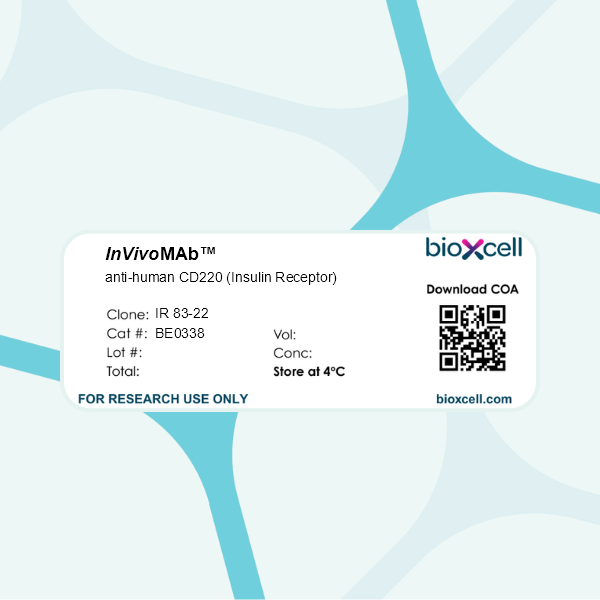InVivoMAb anti-human CD220 (Insulin Receptor)
Product Description
Specifications
| Isotype | Mouse IgG1 |
|---|---|
| Recommended Isotype Control(s) | InVivoMAb mouse IgG1 isotype control, unknown specificity |
| Recommended Dilution Buffer | InVivoPure pH 7.0 Dilution Buffer |
| Conjugation | This product is unconjugated. Conjugation is available via our Antibody Conjugation Services. |
| Immunogen | Human IM-9 lymphocytes |
| Reported Applications | Western blot |
| Formulation |
PBS, pH 7.0 Contains no stabilizers or preservatives |
| Endotoxin |
≤1EU/mg (≤0.001EU/μg) Determined by LAL assay |
| Purity |
≥95% Determined by SDS-PAGE |
| Sterility | 0.2 µm filtration |
| Production | Purified from cell culture supernatant in an animal-free facility |
| Purification | Protein G |
| RRID | AB_2894758 |
| Molecular Weight | 150 kDa |
| Storage | The antibody solution should be stored at the stock concentration at 4°C. Do not freeze. |
| Need a Custom Formulation? | See All Antibody Customization Options |
Application References
Western Blot
Soos, M. A., et al (1986). "Monoclonal antibodies reacting with multiple epitopes on the human insulin receptor" Biochem J 235(1): 199-208.
PubMed
Monoclonal antibodies for the human insulin receptor were produced following immunization of mice with IM-9 lymphocytes and/or purified placental receptor. Four separate fusions yielded 28 antibodies, all of which reacted with receptor from human placenta, liver and IM-9 cells. Some antibodies cross-reacted to varying degrees with receptor from rabbit, cow, pig and sheep, but none reacted with rat receptor. At least 10 distinct epitopes were recognized as indicated by species specificity and binding competition experiments. All of these epitopes appeared to be on extracellular domains of the receptor as shown by binding of antibodies to intact cells. In some cases the epitopes were further localized to alpha or beta subunits by immunoblotting. Several antibodies inhibited binding of 125I-insulin to the receptor, some had no effect on binding, and others enhanced the binding of 125I-insulin. It is concluded that these antibodies will be valuable probes of receptor structure and function.

